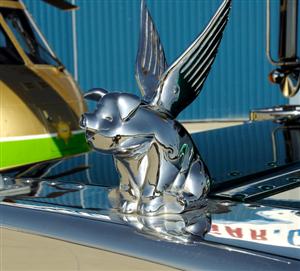COVER FEATURE - DECEMBER 2006
TRUCKERS
WITH BADGES
L.A.COUNTY SHERIFF’S “TRUCKING” UNIT
By Daniel J. Linss
- Editor
As one of the oldest and largest law enforcement agencies in the country, the Los Angeles County Sheriff’s Department (LASD) needs a lot of stuff to operate effectively. In 1969, the federal government started a program that allowed law enforcement agencies access to military surplus at little or no cost. The LASD has been involved with this program since the beginning, and today has three trucks and four deputies, working full time, who travel all across the country to pick up this surplus and then bring it back to Los Angeles. Sergeant Robert S. Watkins, who was just recently promoted from Deputy, has been running this unit for the last eight years. Coming from a trucking background, Robert brought his love of trucks and trucking with him when he came to the unit, and today has the privilege of running a super-clean rig on behalf of the Sheriff’s Department. Yes, that’s right – he’s a trucker with a badge and a gun!
The Federal Excess Property Utilization Program, which is ran by the Department of Defense, allows law enforcement agencies across the country access to military surplus items (new and used) including vehicles, weapons, clothing, office supplies, etc. Every item in the military has a Table of Allowance, or TOA. This TOA specifies how much equipment each unit can have at any one given time. For example, if the TOA for tanks is 100 per unit, each unit cannot have more than 100 tanks. If they want to add ten newer, more advanced tanks to their unit, they must first get rid of ten of the old ones (and in some cases, the “old” ones are still brand new). Everything has a TOA: trucks, guns, pencils, blankets, helmets, rolls of toilet paper, everything. This is why so many surplus items are always available.
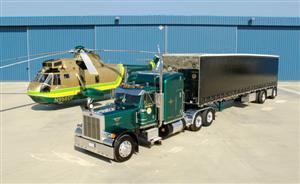 When
an item is determined to be surplus, it is sent to a DRMO (Defense Reutilization
and Marketing Office) and then posted on a website where individual agencies
can search for needed items. When an agency finds something that it can
use (and it must use it pretty quickly – stockpiling is not allowed),
they begin a paper trail to transfer ownership of the item to their agency.
Once the paperwork is complete, the agency goes and gets the item (usually
at no cost to the law enforcement agency).
When
an item is determined to be surplus, it is sent to a DRMO (Defense Reutilization
and Marketing Office) and then posted on a website where individual agencies
can search for needed items. When an agency finds something that it can
use (and it must use it pretty quickly – stockpiling is not allowed),
they begin a paper trail to transfer ownership of the item to their agency.
Once the paperwork is complete, the agency goes and gets the item (usually
at no cost to the law enforcement agency).
Not long ago, there were 76 of these DRMO’s throughout the entire country, but last year the military consolidated them down to just 17 locations. Before the consolidation, there were seven DRMO’s in California – now there are only two. This has made it much harder for the smaller law enforcement agencies to retrieve the items they want and need, because now they must travel all across the country to pick up their stuff, not just locally. But this change has not really affected the LASD – their department is large enough to have four deputies and three trucks working this program on a full-time basis.
Robert’s unit, which operates out of Whittier, California and saves the taxpayers of Los Angeles County anywhere from four to five million dollars annually, is called the Federal Excess Property Unit. This program keeps Robert and his three deputies extremely busy. You might wonder why the Sheriff’s Department needs so much stuff. Well, the answer is simple: the agency is huge! The LASD is consistently in the top three of the largest law enforcement agencies in the country. The two largest agencies in the country are the New York City Police Department (NYPD) and the Chicago Police Department (CPD). The Los Angeles Police Department (LAPD) and the LASD go back and forth as the third largest agency in the country. Since each department is similar in size, the one that is actively recruiting is usually the larger of the two at that time. Under the direction of Sheriff Lee Baca, the LASD has about 16,000 total employees (about 9,000 sworn deputies and 7,000 support staffers), operates 37 patrol stations, 33 court houses and 6 independent jails. On any given day, about 100 LASD busses take between 2,800 and 3,000 inmates to court. The LASD jail “system” houses between 22,000 and 25,000 inmates a day on average. The Los Angeles County Sheriff’s Department has been in existence since 1850 and is proud to have been the central agency that “tamed” the West.
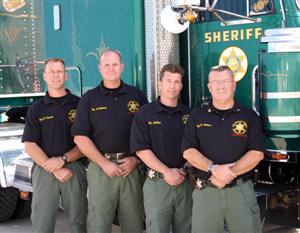 Sergeant
Watkins has been a deputy with the Sheriff’s Department for 26 years.
Back when he first became a deputy, he used to drive a lumber truck at
night for a company in Chino, California. Before becoming a deputy, Robert
spent five years in the Navy and then enlisted in the Marines for another
three. For the last eight years, he has been in charge of the Federal
Excess Property Unit, and it has flourished. About six years ago, he recruited
Deputy John McClure into the unit and then trained him how to drive a
truck. Deputy McClure had no trucking background, but he and Robert had
been partners in the past. John has been a deputy for 18 years.
Sergeant
Watkins has been a deputy with the Sheriff’s Department for 26 years.
Back when he first became a deputy, he used to drive a lumber truck at
night for a company in Chino, California. Before becoming a deputy, Robert
spent five years in the Navy and then enlisted in the Marines for another
three. For the last eight years, he has been in charge of the Federal
Excess Property Unit, and it has flourished. About six years ago, he recruited
Deputy John McClure into the unit and then trained him how to drive a
truck. Deputy McClure had no trucking background, but he and Robert had
been partners in the past. John has been a deputy for 18 years.
Over the next few years, the program continued to grow, and it became apparent that more trucks, trailer and deputies were needed. In the last few months, Robert has brought in two more deputies to help – Deputy David Wendlandt and Deputy Daryl Peacock. David has an extensive trucking background (he comes from a trucking family) and has been a deputy for 12 years. Daryl is just getting started in the unit, but has already been a deputy for 17 years. As you can see, this is no “rookie” force. The deputies in this unit have almost 75 years of combined experience.
The unit’s flagship truck is the 1988 Peterbilt 379 featured on our cover/centerfold this month (and on this page). Painted Metallic Forest Green with Sable Black fenders, this rig, which is adorned with official Los Angeles County Sheriff’s Department logos, has a 444 Cummins under the hood, a 13-speed transmission, 3.55 rears and a 258-inch wheelbase. The rig features a few exterior accessories, like full fenders, deck plating, LED lights and some stainless steel accent pieces, but for the most part it is a stock truck. The truck usually pulls a black, 48-foot, 2006 Western Curtain Van with a 10-foot spread, painted rails to match the tractor, and custom stainless tool boxes, but it also pulls many of the other trailers in their fleet, depending on the cargo they are hauling.
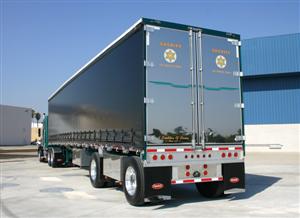 Presently,
the unit has three tractors and seven trailers, including flatbeds, drop-decks
and dry vans, in addition to the curtain van. Deputy McClure’s truck is
a 1997 Peterbilt 379 with a Cat 3406, a 13-speed transmission, 3.55 rears
and a 264-inch wheelbase. Deputy Wendlandt’s truck is a classic 1985 Peterbilt
359 in immaculate condition. This truck, which only has 250,000 original
miles, runs great and is still tight. This rig has a 400 Cummins, a 13-speed
transmission and 3.55 rears – and the interior is like new. In the coming
months, Robert plans on having both of these trucks painted green like
his, and hopes to be able to take all three of them (with trailers) to
the local truck shows in 2007. Currently, Deputy Peacock does not have
his own truck, so he acts as a fill-in driver wherever and whenever he
is needed.
Presently,
the unit has three tractors and seven trailers, including flatbeds, drop-decks
and dry vans, in addition to the curtain van. Deputy McClure’s truck is
a 1997 Peterbilt 379 with a Cat 3406, a 13-speed transmission, 3.55 rears
and a 264-inch wheelbase. Deputy Wendlandt’s truck is a classic 1985 Peterbilt
359 in immaculate condition. This truck, which only has 250,000 original
miles, runs great and is still tight. This rig has a 400 Cummins, a 13-speed
transmission and 3.55 rears – and the interior is like new. In the coming
months, Robert plans on having both of these trucks painted green like
his, and hopes to be able to take all three of them (with trailers) to
the local truck shows in 2007. Currently, Deputy Peacock does not have
his own truck, so he acts as a fill-in driver wherever and whenever he
is needed.
And speaking of the truck shows, Robert has been taking his truck out to many local shows for years now. Going to five or six shows a year has allowed Robert and his deputies the opportunity to educate the people about their unit and make a good impression. Law enforcement officers and truckers have historically been thought of as “enemies” to one another, but in reality, these two groups have always worked together for the betterment of the industry. Coming together at a truck show helps break down defenses and brings the two groups to the same level, where they can relate to each other and communicate more effectively. Truckers mostly want to know why the Sheriff’s Department has a big rig and what they do with it, but sometimes they’ll ask a silly question like, “Do you pull people over in that rig?” They also frequently ask, “Do you listen to us truckers on your CB when you are out on the road?” The answers are no and yes – they cannot pull people over in a vehicle without red lights and a siren and, when they get out on the road, they just consider themselves “truckers with badges” so of course they listen to the other drivers on their CB radio.
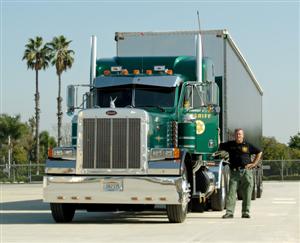 Pictured
here and on the centerfold this month, Robert’s truck can be seen parked
next to one of the unit’s more prominent acquisitions – a Sikorsky H-3
Sea King helicopter. In fact, the unit purchased five of these birds through
Congress from the U.S. Navy for the whopping price of $1.00 each (you
gotta love our Congress). The H-3 Sea King helicopter was designed as
an anti-submarine and water rescue vehicle, but the LASD uses it for mountain
rescues and troop deployment. The helicopter features twin T58 GE engines
and can land and float in water (the front is shaped like the hull of
a boat). The Sea King is also used as the official helicopter of the President
of the United States. It is known as Marine One when the president is
actually aboard. The LASD currently has five of these large H-3 Sea King
rescue helicopters and 14 of the smaller patrol models, which are all
based out of the Sheriff’s Aero Bureau at Long Beach Airport. This is
also the location where we took all of our pictures.
Pictured
here and on the centerfold this month, Robert’s truck can be seen parked
next to one of the unit’s more prominent acquisitions – a Sikorsky H-3
Sea King helicopter. In fact, the unit purchased five of these birds through
Congress from the U.S. Navy for the whopping price of $1.00 each (you
gotta love our Congress). The H-3 Sea King helicopter was designed as
an anti-submarine and water rescue vehicle, but the LASD uses it for mountain
rescues and troop deployment. The helicopter features twin T58 GE engines
and can land and float in water (the front is shaped like the hull of
a boat). The Sea King is also used as the official helicopter of the President
of the United States. It is known as Marine One when the president is
actually aboard. The LASD currently has five of these large H-3 Sea King
rescue helicopters and 14 of the smaller patrol models, which are all
based out of the Sheriff’s Aero Bureau at Long Beach Airport. This is
also the location where we took all of our pictures.
With the recent change of power in Congress and the subsequent expected slowing of the war-effort in Iraq, Robert and his deputies are preparing for a glut of surplus to hit the DRMO’s in the not-so-distant future, as many units return home. If more trucks are needed for the unit, they will add them, but it’s more likely that they will only be looking to add a few more trailers at this point. Sergeant Watkins is proud of the fact that his unit doesn’t “cost” the taxpayers of L.A. money but instead “saves” them a bunch. He is also proud to be in 10-4 Magazine, citing that he is in good company with so many other terrific people and trucks.
So, if you happen to see Sergeant Watkins or one of his deputies at a truck show or out on the road, give them a wave, say hello or just offer them a thumbs up. Remember, they are truckers just like you – with two exceptions – they wear a badge and carry a gun, so you better be nice!
Copyright
© 2006 10-4 Magazine and Tenfourmagazine.com
PO Box 7377 Huntington Beach, CA, 92615 tel. (714) 378-9990 fax
(714) 962-8506

